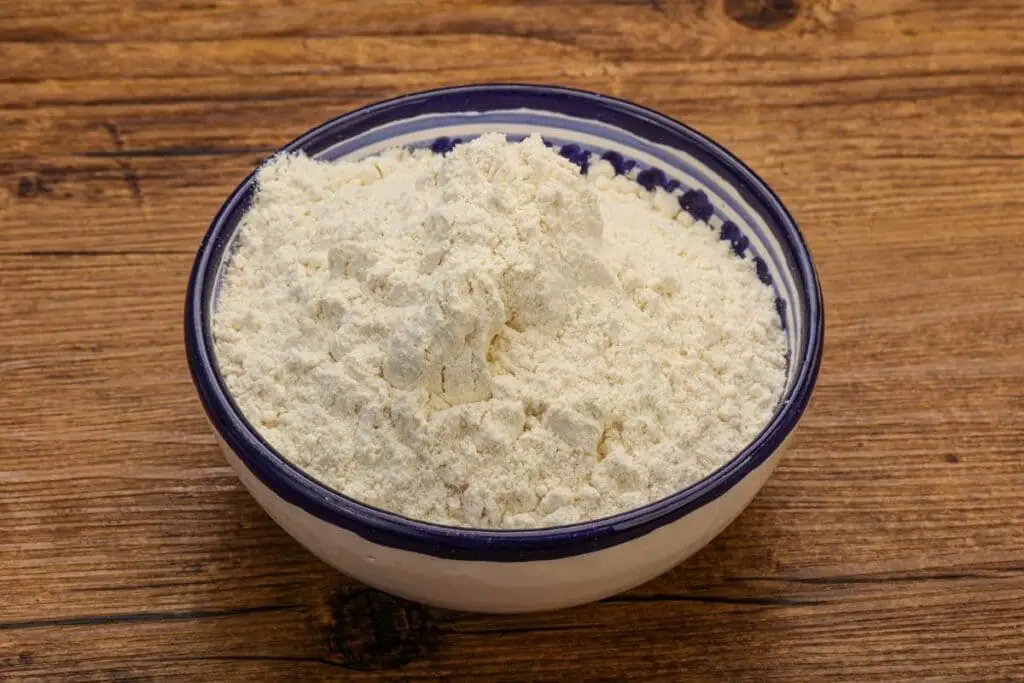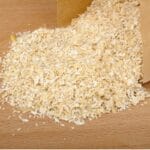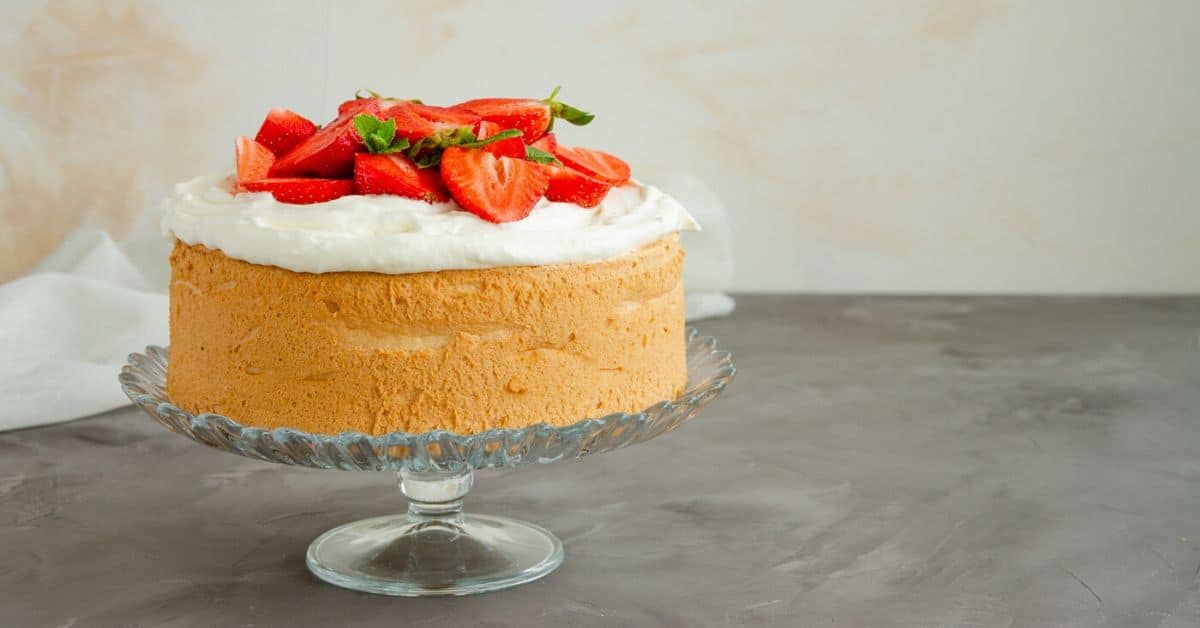In short, the best alternatives to wheat flour include almond flour, coconut flour, oat flour, rice flour, etc. We also suggest choosing a substitute based on the type of recipe and dietary needs below.
Wheat flour is an incredibly versatile ingredient and a staple in many countries.
Initially, you may think of it as a baking ingredient, but it is used in so many more applications than just bread, cookies, pastries, pizza, muffins, and cake. It’s also used as a thickener for sauces and soups, as a coating for crumbed or fried items, in pasta, and cereals.
In fact, once you start checking food labels for ingredients, it may be hard to find prepared meals, frozen items, or packaged items that don’t contain wheat flour.
More people have started opting for gluten or wheat-free products, and they have become increasingly available. However, it can depend on your location.
However, many products are not available in wheat-free versions and require a little more homework on your part.
Whether you’re catering to gluten-intolerances or have run out of wheat flour, we’ve got an extensive list of wheat flour alternatives you can use instead. Although, there are a few things you need to know before just picking one from the list.
Consideration When Baking Wheat-Free
It is important to know that there is a difference between gluten-free foods and wheat-free foods. Something that is free of wheat can still contain gluten. For example, barley and rye grains contain gluten. So if you suffer from celiac disease, you should avoid more than just wheat products.
Products for people with severe gluten allergies need to be labeled as gluten-free. They must be checked for cross-contamination if processed in factories that also handle gluten-containing products. Food labels will generally state if this is the case.
Grains or products that are labeled as gluten-free will automatically be wheat-free. So if you have an intolerance or allergy to wheat, you can eat anything that is labeled as wheat-free as well as gluten-free.
An allergy is, however, not the only reason you may be looking for a substitute. Different types of grain, nut, and starchy vegetable flours react differently to heat and liquids. Some are incredibly dense and crumbly, while others can provide you with a much more crunchy texture when frying.
Gluten is the component in wheat and other gluten grains that creates stretchy dough and air pockets for light and fluffy bakes. Without gluten, it can be challenging to achieve the same lightness in texture. This is why you cannot just substitute any flour in equal amounts when replacing wheat flour.
You will need to combine different flours, adjust ratios, and sometimes add in a few extra ingredients. However, when substituting wheat for thickening or coating purposes, things can be a lot more simple and can often be done in a straight swap.
Types of Wheat Flour
Different types of wheat are used for different purposes to obtain the ideal results. Yeast loaves are best made from hard red and white wheat, while soft wheat is what we generally use in cakes, crackers, and most other baked items. Durum wheat is popularly known for its use in pasta and is the hardest of the wheat varieties.
They all, however, have a very neutral taste and are almost flavorless, making the perfect blank canvas for whatever flavor profile you want to create.
All-Purpose
As its name suggests, this refined white flour is made from hard and soft wheat, suitable for all purposes, from yeast bread and pizza bases to cakes, cookies, coatings, batters, and pastry.
The bran part of the kernel is removed during the milling process, leaving a fine white powder. Most brands sold in the US are fortified with naturally occurring vitamins and minerals that are lost in the milling process.
Bread Flour
This type has a higher gluten content, making it ideal for yeast bread, donuts, and the like. It’s generally intended for commercial use but can be purchased at most grocery stores.
Self-Rising
A quick-fix to keep your recipe simple, self-rising flour already contains baking powder and salt so you can decrease the quantity of these ingredients in your recipe. It’s not recommended for yeast bread but is a great go-to for quick pancakes, cookies, and biscuits.
Related: Substitute for self rising flour
Cake Flour
Although this is very similar to all-purpose flour, it has a slightly more refined texture since it is made from refined soft wheat. It is ideal for keeping cakes and pastries delicate in texture.
Semolina and Durum Flour
Semolina is the coarsely ground endosperm of the hardest type of wheat, namely durum wheat. Durum flour is a by-product of semolina production. These are both used to make pasta and couscous.
Whole Wheat Flour
Unlike refined flours, whole wheat contains the entire kernel, including the fibrous bran. The bran’s presence in the flour reduces gluten development resulting in slightly denser products.
Products including this fiber are often more filling to eat, darker in color, and have a higher fiber content.
Best Wheat Flour Substitutes and How to Use Them
1. Rye
Although it contains a small amount of gluten, rye flour lacks sufficient gluten development properties to allow for a light texture and well-risen product. When rye is used in baking recipes on its own, it produces a very dense product with a sticky dough.
Best used for: Bread, muffins, pancakes, cookies.
Substitute quantity: The best way to use rye flour is to combine it with wheat flour. Replace 1/3 of the wheat flour for rye. You may want to use additional yeast when baking with rye.
2. Almond Flour
This is a gluten-free flour, low carb, and has a lovely nutty flavor. It is used in baking items such as macaroons and some other pastries or bread.
Almond flour is best used in baking recipes that are specifically created for it. These recipes use whipped egg whites as the airy component instead of relying solely on baking powder or other raising agents due to the lack of gluten.
Substituting almond flour directly in any recipe will most likely yield a very dense and heavy product. For this reason, we recommend only using this as a straight swap for recipes that require just a very small amount of flour or for coating.
Best used for: Dredging fried chicken, crumble toppings, thickening, and coating.
Substitute quantity: When coating meats or vegetables for a fried or baked crust, substitute in equal quantities.
See more: Almond flour replacement
3. Amaranth
If you just want to cut down on wheat products but don’t need to avoid it completely, you can substitute no more than half the amount of flour in your recipe with amaranth flour.
It is high in protein and does not contain gluten, so expect a slightly denser baked product. It is best to keep it stored in an airtight container in the refrigerator.
Best used for: Yeast bread, cookies, and cakes.
Substitute quantity: Not suitable as a 1 on 1 substitute but can replace 25 to 50% of the wheat flour in your recipe for a flour combination.
4. Arrowroot
Also referred to as arrowroot powder or starch, this thickening agent is made from a high-starch, low-protein arrowroot tuber. Its neutral taste makes it ideal for use in sweet and savory recipes.
It has some unique properties that add a little shine to soups and stews instead of making them appear cloudy and does not break down when combined with fruit juices or other acidic ingredients.
Arrowroot is best only used for thickening purposes in cooking as a replacement on its own. However, when combined with a variety of other gluten-free flours, it can make delicious chewy cookies.
Best used for: Thickening soups, sauces, and stews.
Substitute quantity: Replace 1 teaspoon arrowroot flour for every 1 tablespoon wheat flour when used for thickening liquids. (Do not apply this to baking!)
4. Barley Flour
Barley is a healthy grain that is high in fiber. It does contain gluten. However, it is best combined with wheat flour for better results in baking.
Best used for: Thickening soups, stews, and baking bread and cookies.
Substitute quantity: When making health bars, cookies, or bread, substitute half of the total amount of flour required with barley flour for a combination.
5. Buckwheat
You can grind your own buckwheat flour at home with a coffee grinder or food processor. It has a nutty undertone, is high in fiber, and is free of gluten.
When used as a replacement for wheat in cakes, it is best combined with another flour since it can be chalky and dense on its own.
It is a popular option for pancakes and waffles. For the best outcome, use a recipe specifically for buckwheat pancakes or waffles instead of doing a direct swap in your regular recipe.
Best used for: Recipes that don’t require the mixture to rise, such as pancakes, waffles, and cookies. It can also be used in some dense bread recipes.
Substitute quantity: Mix it with another flour in a 1:1 ratio when using it as a substitution or use a recipe specifically created with buckwheat.
6. Corn Flour
This is best used as a thickening agent or for coating fried items. It doesn’t absorb as much oil when used as a coating and yields a great crispy texture. It has double the thickening properties of wheat.
Due to it being gluten-free, it can’t be used as a straight swap for wheat in baked items but can be mixed with other types of flour.
Best used for: Coating chicken, meat, and fried items. Thickening soups, sauces, and stews.
Substitute quantity: Only use half the amount of corn flour than wheat required in the recipe for thickening sauces, stews, and soups. If your recipe requires two tablespoons of wheat flour, use one tablespoon of cornflour instead.
See more: Cornmeal alternatives
7. Millet
Millet flour can deteriorate quickly if not properly stored, so ensure to keep it in an airtight container in a cool, dry place. To create a gluten-free all-purpose blend, Millet is best combined with alternative flours, such as oat, rice, or tapioca flour.
Best used for: Waffles, pita, and bread.
Substitute quantity: Best combined with other flours for baking. Alternatively, replace only ¼ of the flour in your recipe with millet to add a unique taste.
8. Oat
The great thing about oat flour is that you can make your own at home by grinding regular oats in a spice or coffee grinder or blender.
Unless you specifically buy gluten-free oats, it will have a small amount of gluten present but not enough to hold the same amount of rising as regular flour. It is, therefore, best mixed with other flours when used as a substitute.
Best used for: Cookies, muffins, pancakes, bread, thickening, and coating.
Substitute quantity:
- Best combined with other flours for baking when used as a replacement.
- Replace in equal amounts for thickening, crumble toppings, and coating.
- For cakes and recipes that require a lot of rise, replace only ¼ of the flour in your recipe with oat flour.
See more: substitution for oat bran
9. Brown Rice
White or brown rice flour can be used in baking and dredging. However, brown rice has more fiber and is the healthier option. Its gluten-free properties make it yield very dense baked goods.
It can be mixed with other flours to create the ideal gluten-free all-purpose mix and is also a good option to use in crumbly biscuits. Make your own rice flour at home by grinding rice in a mill or coffee grinder.
Best used for: Dredging fried chicken or other deep-fried products, crumbly cookies, baked items when combined with other types of gluten-free flours.
Substitute quantity:
- Rice flour can be used in the same way as corn starch to thicken stews.
- Replace measure for the measure when using as a coating for deep-fried items.
- When baking cookies, you will need to add xanthan gum and possibly adjust liquid or egg proportions. We recommend using a recipe designed specifically for rice flour.
10. Tapioca Flour
This thickening agent is made from a high-starch, low-protein cassava plant. It has a very neutral flavor making it ideal for use in sweet and savory recipes. It is best only used for thickening purposes in cooking when used as a replacement.
Best used for: Thickening soups, sauces, and stews.
How to substitute: Replace in equal quantities for thickening.
See more: Tapioca starch substitute
11. Teff Flour
Teff grains are very small and therefore not suitable for grinding yourself at home in a blender. You can, however, use a mill or stone grinding method. It is gluten-free and highly nutritious compared to other grains, and pretty versatile.
Best used for: Cookies, pancakes, thickening sauces, stews, and soups.
Substitute quantity: Best combined with other flours for baking. Alternatively, replace only ¼ of the flour in your recipe with teff flour to add a unique taste.
FAQs
Conclusion
Wheat flour is incredibly diverse, and it is hardly possible to find a single substitute with all the same characteristics. That’s why it is best to choose your replacement using the properties you are after, whether it is thickening, binding, providing a fluffy texture, crunch, or offering a light risen structure.
Flours that don’t contain gluten will yield a much denser baked product and are best blended and used with additional raising components such as whipped egg whites, yeast, and xanthan gum.
Once you’ve started experimenting and get used to how gluten-free flours act, you’ll discover a whole new world of healthy baking with endless options!
See more: Does flour go bad?
*image by AndreySt/depositphotos









